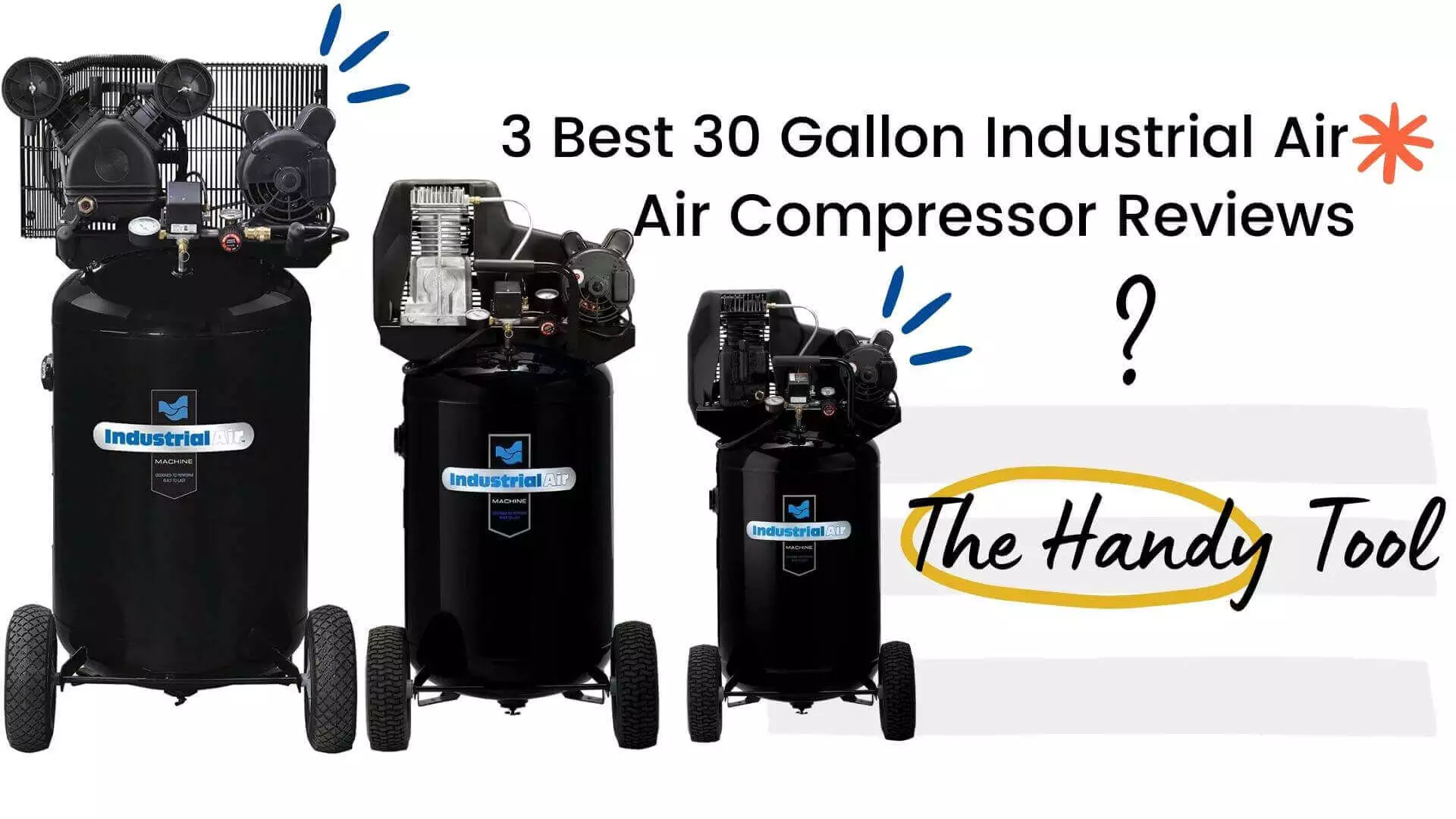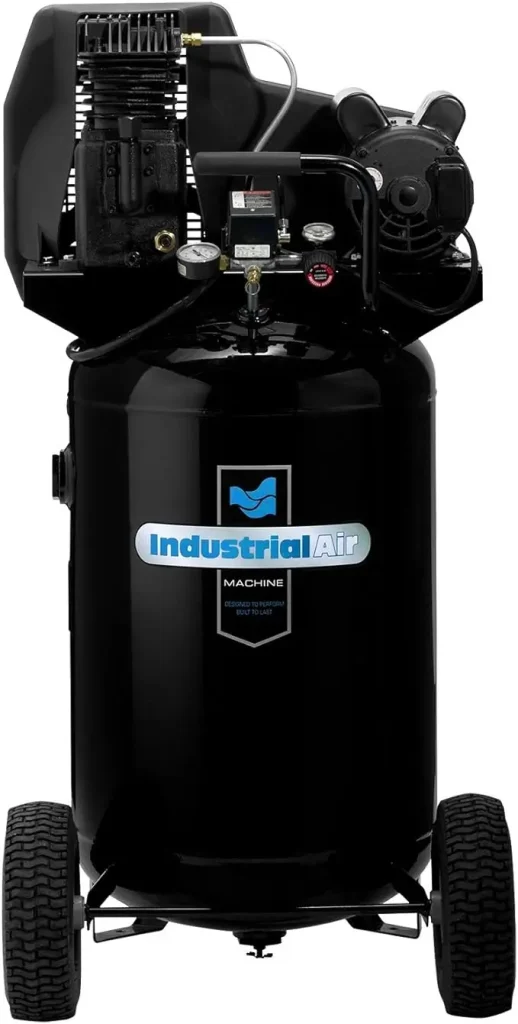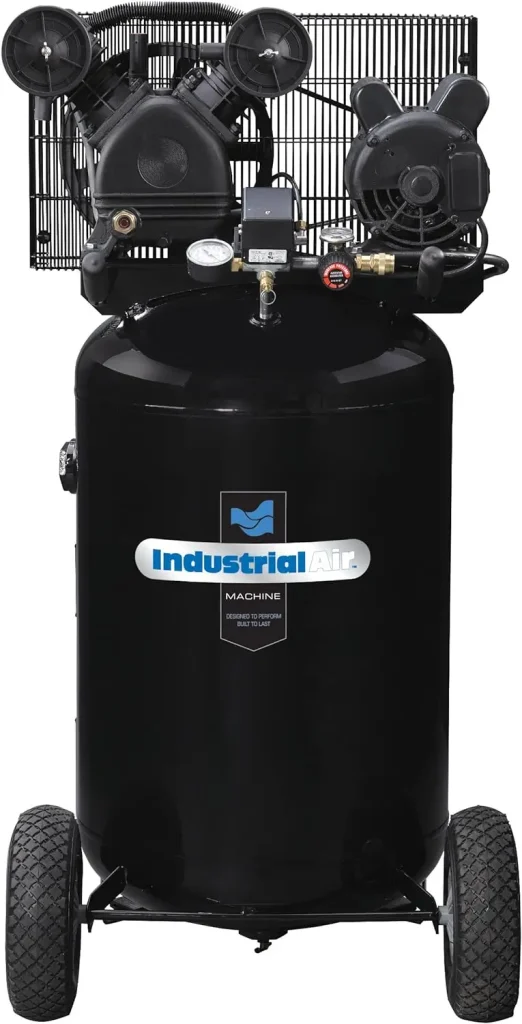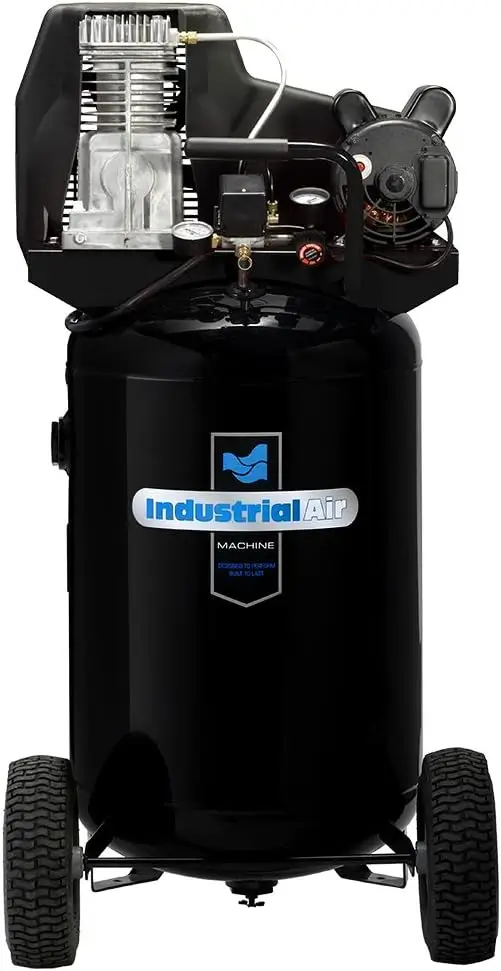It’s not always the high and mighty dedicated tools that get the job done. Sometimes, all we want is the jack of “most” trades.
A 30-gallon air compressor is the epitome of this jack of “most trades”.
I wanted an air compressor that’ll give me a hand in some casual DIY tasks. But I also needed a bit more oomph to use my light pneumatic tools. I didn’t want to invest in a high-end compressor. But I also didn’t want something that’ll just be limited to lightweight tasks.
I use my sandblasters and plasma cutters often. And I wanted something that’d not only inflate the tires but will give me access to these tools as well.
That’s where the 30-gallon air compressors came into play.
If you’re up to speed with your air compressor knowledge, you already know that Industrial Air has been in this game for decades. Their compressors live up to the brand’s reputation. I’ve used quite a few of them, and it’s safe to say that I have my fair share of experience with Industrial Air.
So, I’ve decided to drop all my knowledge bombs in the Industrial Air 30-gallon air compressor reviews. It’ll contain all my years of wisdom. I’ll break down the top 3 models, give my take on compressor selection, and answer a few common questions. In short, you’ll have a complete blueprint by the end of this article. Moving on.
Top-Rated Industrial Air 30-gallon Air Compressor Reviews
As I said earlier, I’ll discuss only three models. I’ve tried my hands on a lot of different air compressors. So, I can filter the real benefits from the pretense. I’ll highlight the benefits, but I’ll make sure you get the dirt on each model as well.
1. Industrial Air ILA1883054 30-Gallon Air Compressor Review
Best 30 gallon industrial air compressor reviews
Industrial Air ILA1883054 30-Gallon Belt Driven Air Compressor
Industrial Air
I’ve been let down by the air compressors I’ve owned before. I know how it feels when the tank takes forever to fill up, the leak becomes unbearable, or the noise just drives the sanity out of one’s mind.
So, when I got my hands on the Industrial Air ILA1883054, I was highly skeptical. But my frown was turned into a smile in just a couple weeks. Why? That’s what I’m going to tell you in this Industrial Air ILA1883054 30-gallon review.
A lot of people make a fuss about the PSI and CFM ratings. Let me give it to you straight. The 155 PSI this air compressor delivers is reasonable enough for a small-scale workshop. As far as CFM goes, the ILA1883054 can dish out 5.7 CFM at 90 and 7.0 CFM at 40 PSI. That’s more than enough for casual tasks like pumping a sedan tire, inflating basketballs, or even running the average plasma cutter.
Plus, the below-average compressors build up a ton of heat regardless of the workload. The good thing about the ILA1883054 is that it has a combination of cast iron and aluminum. Let’s talk science now. Cast iron has a low heat conductivity. So, it’ll take a lot of time to get heated. But once it reaches that point, cast iron tends to remain rooted there.
That’s where the aluminum head comes to save the party. Aluminum, in contrast, has a high thermal conductivity. So, it can function as a heat sink. It’s like a ying-yang thing going on here.
Also, the cast-iron construction makes this air compressor sturdy. I’ve banged the compressor many a times during relocation. But I’ve never noticed a drop in performance.
Now that I’ve mentioned relocation, I should add that it was pretty easy. The pneumatic wheels on this machine took the load off my shoulder. I just pushed it around without a hitch. One more thing- the ILA1883054 is a vertical air compressor. So, that makes moving around even easier.
Adding to the “moving around” benefit, the dual voltage option also is a cherry on top. Let’s say you move somewhere without the 120V standard outlet. You can still operate it with a 240V outlet. This Industrial Air 30-gallon vertical air compressor makes relocating convenient.
Everything I needed to operate the compressor was right in front of me. The front part has the switch, regulator, and pressure gauge. So, I didn’t have to go back and forth to change the settings when I needed it.
However, not everything on this compressor is easily accessible. The drain valve is lodged in a place that’s hard to reach. Even if you set it up keeping this drawback in mind, the problem will persist. Also, I would’ve liked the power cord to be a tad bit longer.
Still, the ILA1883054 has a lot going for itself. This stand-alone air compressor can take care of lightweight workshop tools and other small home tasks. Not to mention the 2-year limited warranty sweetens the deal even further. With all these benefit-driven features, the ILA1883054 is a top-notch air compressor.
2. Industrial Air ILA1683066 30-Gallon Cast Iron Oil Lube Air Compressor
Industrial Air ILA1683066 30-Gallon Cast Iron Oil Lube Air Compressor
Industrial Air
After being very satisfied with the ILA1883054, I tried out a few more compressors of Industrial Air. Among all the compressors, I found the Industrial Air ILA1683066 30-Gallon cast iron oil lube air compressor to be one of the best for home shops.
Truth be told, 30-gallon was an overkill for my home shop and garage. I realized that I didn’t need this much pressure or power for my plasma cutter or sandblaster. I could’ve worked with something less powerful but chose to work with the ILA1683066 instead.
Okay, enough with what could’ve been chitter-chatter. It’s time I share my experience with you guys.
For starters, the compressor has 155 maximum PSI. It is actually more than enough for machines like sandblasters or plasma cutters. However, if you ever feel the need to use some industrial tools with the compressor, you can easily do it with the high PSI.
The overall build of the unit is praiseworthy. It features cast iron and can take a good beating before falling into pieces. I’ve never tried roughhousing it but by the looks of the exterior, the compressor could’ve easily taken a decent amount of external impact.
The twin-cylinder pump also comes with a valve plate and aluminum head which work to keep the heat buildup in check. Therefore, I never had to worry about overheating issues that lead to engine dysfunction.
Apart from that, it has two cylinders tucked inside the body and the pump is oil lubricated. You can use the compressor with either 120 or 240-volt power outlets. So, you have the luxury to convert the motor for applications that require a power outlet of 240-volt.
The entire thing came fully assembled so that was sweet. It saved me a lot of time, which is usually the case for many other compressors. Furthermore, I didn’t have to work my butt off just to make it work. It is really annoying when you have to assemble the entire product and connect it with the power tools.
If you take a look at the top of the compressor, you will see a red regulator. It is known as the quick-set regulator which you can use to control the pressure of the tank. The working and tank pressure gauges are situated on the left and right of the switch. Hence, it is very easy to keep a track of the amount of pressure you are using for your power tools.
Additionally, there is an air outlet with an on/off switch near the gauges. There is also a set of pneumatic wheels under the tank. With the help of the front handle and the wheels, it becomes a piece of cake to move around the compressor.
The only thing, which is also a very minor problem I’ve seen in the tank is the antivibration footpads. It is supposed to stop the compressor from vibrating but no such luck. I used a rug for a few days and after a while changed the pads. It did the trick and now no vibration issues.
I haven’t found or come across any other problems with the tank till now. By the looks of it, I will not for a very long time. This is truly a state-of-the-art machine and per my judgment the best 30-gallon industrial air compressor.
3. Industrial Air IL1983013 30-Gallon Oil Lube Belt Drive Air Compressor
Industrial Air IL1983013 30-Gallon Oil Lube Belt Drive Air Compressor
Industrial Air
We are down to the last one. I must admit it was not easy to decide which one is better than which. All of them were equally good. Honestly, they are pretty much the same except for some minor differences. However, there is always a first, second, and third in every contest. So, let me tell you why I have put the Industrial Air IL1983013 at third on my list.
The compressor was suggested to me by a friend. When he got to know that I was trying out Industrial Air tanks, he told me to check out the IL1983013. As per his suggestion, I tested out the compressor and was very glad that he introduced it to me.
As you can already see from the title, the 1.9 HP tank is about 30-gallons. The maximum PSI it can generate is about 130. It is not as much as the ILA1683066 but can get the job done. However, industrial projects often require a working PSI of 150 or higher. If that is the case then check the previous product.
Nevertheless, I liked how the compressor allowed me to select from different output options. For instance, 5.7 CFM at 90 PSI and 7.1 CFM at 40 PSI. It is very convenient when you require specific pressure for particular tools.
Additionally, the cylinders are made up of cast iron for extended durability. There are also aluminum cooling fins to reduce heat production. The combination of cast iron and aluminum cooling fins enables the tank to maximize CFM. The compressor features welded axle plates to further increase its durability.
Similar to the last compressor, this one also comes with a dual voltage induction motor. It is usually set to 120-volt but you have the option to convert it to 240-volt for heavy-duty projects.
The tank and pressure gauges are at the top. The air outlet, regulator, and on/off switch are also there; so, it is very easy to maneuver as everything you need is nearby. As the compressor is oil-lubricated, naturally, it will have a glass oil sight. But don’t worry the meter is also visible up at the top.
Apart from that, you will find two wheels at the bottom, which make it easy to move the tank. The tank is about 160 pounds and it takes a lot of muscle to drag it from one place to another. However, with the handle and wheels, it becomes a walk in the park.
The only downside to the compressor is the maximum PSI. I would’ve placed it second on the list if the maximum PSI was near 150. Nevertheless, it is still more than capable enough to handle power tools that you use in home shops or garages.
Buying Guide
(Tips to Identify the Top Industrial Air 30-Gallon Air Compressors)
Although Industrial Air is the top dog in the air compressor scene, not all of their compressors are of the same caliber. As I’ve had first-hand experience with these machines, I know what works and what doesn’t. So, the factors I’m going to list out are going to guide you through the entire buying process.
- A Build That Lasts
Build quality is not a feature you want to sleep on. Air compressors are usually stored in workshops. I don’t know about you, but most of the time my workshop is pretty messed up. So, the build of a top-tier air compressor should be sturdy enough to withstand harsh working conditions.
Besides, what materials are used for the construction plays a major role in determining the heat dissipation capacity of the compressor. As I mentioned in the Industrial Air ILA1883054 30-gallon review, a cast-iron body takes time to build up heat. And aluminum functions as a heat sink. So, the combination of these two materials can resist undue heat buildup and save your compressor from burning out.
Remember, a 30-gallon air compressor is different from the portable, home-use versions. It has more range when it comes to performance. But that also means it has to be more durable to endure the stress of regular use.
- Movement Flexibility is Important
Any compressor below 10-gallon is way more portable than the 30-gallon alternatives. But it doesn’t mean that the latter is a fat kid that struggles to move around. After you’re done looking into the build quality, you should check whether the compressor is portable.
All the Industrial Air compressors I’ve mentioned in this article have pneumatic tires attached to them. With just a little upper-body strength, you should be able to move it around the workplace without having to break your back.
Plus, all the compressors on this list are vertical. However, horizontal compressors can give you a lot of freedom to move around as well. But vertical ones take up less space, giving you more room to store other machines in your garage or workshop.
- The Controls Should Be Manageable
Operating an air compressor is a tricky business. Once everything is set up in the right order, it isn’t that big of a deal. However, the controls, if they’re not placed in convenient locations, can cause you a lot of trouble.
For instance, if the regulator, pressure gauge, and all the other essential adjustment knobs are on the back where the motor is, you’ll have to move every time you need to change the settings.
Good news is that all the Industrial Air compressors I’ve reviewed here have the controls right in front. You’ll have access to all the adjustment regulators you need without having to move. However, some stuff, like the drain valve in the ILA1883054, is not easy to reach.
Anyways, the point is- make sure the controls are placed in a convenient spot from where you’ll get quick and easy access.
- Knowing How to Read the PSI and CFM Numbers
This consideration is pretty obvious, but I’m still going to talk about it a little. The PSI and CFM numbers will decide what tools you can or can’t use. All the compressors listed here in the Industrial Air 30-Gallon air compressor reviews have the capacity to handle a lot of different tasks.
Let me show you what you can do with these bad boys. Before I crunch the numbers, I should remind you that The Industrial Air Compressors on this list averages 5.3 CFM at 90 PSI. However, the IL1983013 can deliver 5.7 CFM in a similar PSI range.
1. Brad-Nailer: At a pressure rate of 90 and a CFM of 0.3 only you can easily operate the Brad-Nailer.
2. Pneumatic drills: If you want to use a pneumatic drill, you’ll need something that’s between 3-6 CFM. These compressors can handle most drills without a hitch.
3. Air Chisels: Now, the pressure and volume required for air chisels can vary depending on the tool you have in your arsenal. At 90 PSI, CFM can range between 3-11. If the air chisel you have can work with 3-6 CFM, you’re good to go.
4. Grease Guns: If your car door has been a playground for rust, you can use grease guns to lubricate the hinges. At a pressure rate of 90, all you need is 4 CFM to get this job done.
- Warranty and Customer Service = Full Satisfaction
Warranty is on the wish list of every customer out there, and rightly so. Once I see a warranty, my nerves loosen up because I know the manufacturer has my back. Anyways, a 30-gallon air compressor can take a big chunk out of your wallet. So, it’s better to have a warranty, even if it’s short, than not having any backup at all.
Getting good and responsive customer service tied along with a decent warranty is a match made in heaven. Fortunately, the Industrial Air customer care team is highly responsive. I’ve contacted them and the person on the other end was professional, courteous, and helpful.
- The Noise Level
If you haven’t been around air compressors ever, you probably are unaware of the dangerously irritating noise they make. It can get on your nerves- trust me.
However, the noise of the compressors I’ve listed won’t feel like a knife stabbing your brain. Don’t get me wrong. These compressors also make noise, but it’s tolerable.
Additional Parts You Need to Make These Babies Work
The air compressor on its own won’t be of use to you if you don’t assemble the entire entourage. You need to have a few specific parts backing the compressor up to get the most out of it. I can understand how you would be reluctant to make the additional investment. But it’s a one-time deal. Most of these parts will last for years. So, you’ll get your money’s worth if you don’t mess things up.
- Hose:
You need a discharge hose that’ll deliver the compressed air. Without this part, you can’t get anything done. So, it’s not just to enhance performance, it’s a must-have.
Pro Tip: Choose a hose that’s thick and average in length. Keep in mind that the length will have an effect on performance. Long hoses can take up a lot of energy, and short hoses can limit your movement. Choose wisely.
- Water Separator:
The next item you’ll need is a water separator. Now, unlike the hose which is mandatory, the water separator helps maintain the quality of the compressor. As you use a 30-gallon air compressor, oil, water vapor, and dust will have a party. This so-called party will lead to contamination. So, if you want to keep using your Industrial Air compressor for a long time, better invest in a water separator.
- Air Filter:
When you use the compressor on a daily basis, the air inside the compressor will begin to lose its potency. Although there is a built-in filter to keep the air clean, an external filter will help you maintain its quality. Other perks of using an air filter are- less maintenance, more performance, and the internal parts last longer.
- Additional Regulators:
The Industrial Air compressors I’ve put together all have a regulator to control the pressure and volume. However, professionals always look for more adjustment options. One way of doing it is to get additional regulators attached to the different discharge pipes or hoses to control the flow even better.
Frequently Asked Questions
I’ve answered nearly all the questions you can have about Industrial Air compressors. However, a couple questions keep coming my way from people who want to invest in Industrial Air. So, I’ve decided to address these questions.
I’ve already answered this question in the “understanding the PSI and CFM rating” above. You can use a lot of different pneumatic tools with this compressor. I’ve used nail guns, sandblasters, plasma cutters, and air chisels. Apart from operating lightweight tools, these 30-gallon compressors can also be used to inflate tires, toys, or whatever that needs a good pumping. People mostly use it for two purposes- A) small home-related tasks and B) using a few pneumatic tools for crafting.
The horsepower will vary from one model to another. However, the average horsepower required to run a 30-gallon Industrial Air is 2HP. As the power source is electric outlets, it doesn’t need a lot of horsepower to function.
It can, but I wouldn’t recommend it. The Industrial Air compressors I’ve reviewed in this article are 30-gallon too short to handle car painting. If you want to paint an entire car (undercoating and overcoating), you’ll need a compressor with a CFM range of 4-19. So, I would recommend using a 60-gallon air compressor instead of the 30-gallon Industrial Air. However, you can do some lightweight overcoating, but make sure the paint gun complies with the CFM numbers of your compressor.
With All Said and Done
Now that we’ve reached the finish line, you should have all the information you need to understand the ins and outs of Industrial Air 30-gallon air compressors. These portable machines can help you take your crafting/ DIY game to the next level if you have the right tools at your disposal.
I’ve poured all my experience out here in the Industrial Air 30-gallon air compressor reviews to give you a no-nonsense assessment of these machines. Also, the goal was to present the perks of having a 30-gallon Industrial Air, and whether the greens you put in are worth it.
Well, the answer’s yes- if you know how to use these compressors, you can get a lot of value out of them.
So, from the three compressors I’ve recommended here, I think the ILA1883054 is the best. It has a lot of nifty features that you can make use of once you get the hang of using it.
Remember, always figure out the math before you try out the compressor with any pneumatic tool. I hope you’ll have a better time at your workshop with these compressors like I did, ciao.




